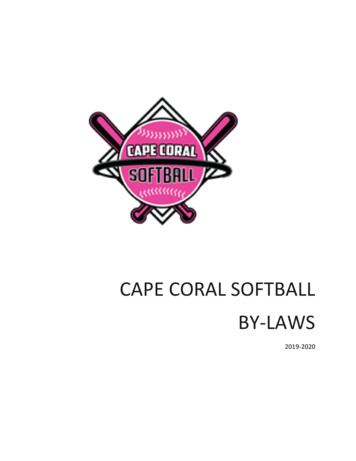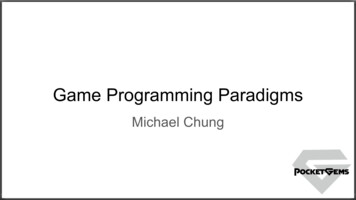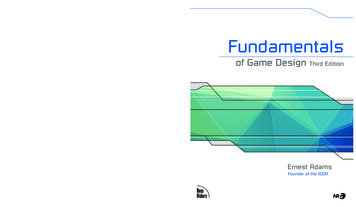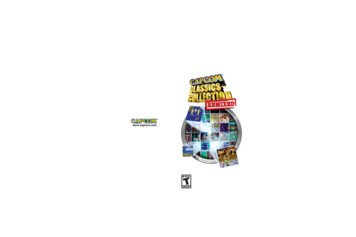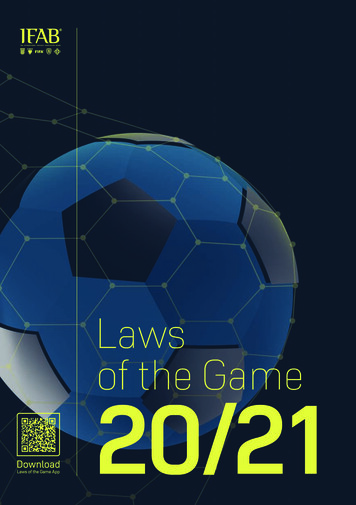
Transcription
Lawsof the Game20/211
23
The International Football Association BoardMünstergasse 9, 8001 Zurich, SwitzerlandT: 41 (0)44 245 1886, F: 41 (0)44 245 1887www.theifab.comThis booklet may not be reproduced or translated in whole or in part in any mannerwithout the permission of The International Football Association Board.Effective from 1st June 20204Lawsof the Game2020/215
Contents9Video Assistant Referee (VAR) protocol150Law changes 2020/21Outline summary of Law changesClarificationEditorial changesDetails of all Law changes1820Notes on the Laws of the Game15623Laws of the Game 2020/21Modifications to the LawsGuidelines for temporary dismissals (sin bins)Guidelines for return substitutes01 The Field of Play02 The Ball03 The Players04 The Players’ Equipment05 The Referee06 The Other Match Officials07 The Duration of the Match08 The Start and Restart of Play09 The Ball In and Out of Play10 Determining the Outcome of a Match11 Offside12 Fouls and Misconduct13 Free Kicks14 The Penalty Kick15 The Throw-in16 The Goal Kick17 The Corner 1281321366140IntroductionThe philosophy and spirit of the LawsManaging changes to the LawsBackground to the 2020/21 revision of the LawsThe tball bodiesFootball termsReferee termsPractical Guidelines for Match OfficialsIntroductionPositioning, Movement and TeamworkBody Language, Communication and WhistleOther advice Advantage Allowance for time lost Holding an opponent Offside Injuries Treatment/assessment after a caution/sending-offL aws o f th e Ga m e 2 02 0/2 1 Co n t e n t s7
Introduction89
The philosophy and spiritof the LawsFootball is the greatest sport on earth. It is played in every country and at manydifferent levels. The Laws of the Game are the same for all football throughoutthe world from the FIFA World Cup final through to a game between youngchildren in a remote village.That the same Laws apply in every match in every confederation, country,town and village throughout the world is a considerable strength which mustbe preserved. This is also an opportunity which must be harnessed for thegood of football everywhere.Football must have Laws which keep the game ‘fair’ as a crucial foundation ofthe beauty of the ‘beautiful game’ is its fairness – this is a vital feature of the‘spirit’ of the game. The best matches are those where the referee is rarelyneeded as the players play with respect for each other, the match officials andthe Laws.The integrity of the Laws, and the referees who apply them, must always beprotected and respected. All those in authority, especially coaches and teamcaptains, have a clear responsibility to the game to respect the match officialsand their decisions.10L aws o f th e Ga m e 2 02 0/2 1 I n t ro d u c t i o n11
Managing changesto the Laws12The first ‘universal’ football Laws were drawn up in 1863 and in 1886The International Football Association Board (The IFAB) was founded by thefour British football associations (The FA, Scottish FA, FA of Wales and Irish FA)as the worldwide body with sole responsibility for developing and preservingthe Laws of the Game. FIFA joined The IFAB in 1913.Football must be attractive and enjoyable for players, match officials, coaches,as well as spectators, fans, administrators etc. The Laws must help make thegame attractive and enjoyable so people, regardless of age, race, religion,culture, ethnicity, gender, sexual orientation, disability etc. want to take partand enjoy their involvement with football.For a Law to be changed, The IFAB must be convinced that the change willbenefit the game. This means that the potential change will usually be tested.For every proposed change, the focus must be on: fairness, integrity, respect,safety, the enjoyment of the participants and how technology can benefit thegame. The Laws must also encourage participation from everyone, regardlessof background or ability.Football’s Laws are relatively simple, compared to other team sports, but asmany situations are ‘subjective’ and referees are human (and thus makemistakes) some decisions will inevitably cause debate and discussion. For somepeople, this discussion is part of the game’s enjoyment and attraction but,whether decisions are right or wrong, the ‘spirit’ of the game requires thatreferees’ decisions are always respected.Although accidents occur, the Laws should make the game as safe as possible.This requires players to show respect for their opponents and referees shouldcreate a safe environment by dealing strongly with those whose play is tooaggressive and dangerous. The Laws embody the unacceptability of unsafe playin their disciplinary phrases, e.g. ‘reckless challenge’ (caution yellow card/YC) and ‘endangering the safety of an opponent’ or ‘using excessive force’(sending-off red card/RC).The Laws cannot deal with every possible situation, so where there is no directprovision in the Laws, The IFAB expects the referee to make a decision withinthe ‘spirit’ of the game – this often involves asking the question, “what wouldfootball want/expect?”The IFAB will continue to engage with the global football family so changes tothe Laws benefit football at all levels and in every corner of the world, and sothe integrity of the game, the Laws and the referees is respected, valued andprotected.L aws o f th e Ga m e 2 02 0/2 1 I n t ro d u c t i o n13
Background tothe 2020/21 revisionof the LawsThe 2016/17 revision of the Laws of the Game started the most far-reachingand comprehensive period of Law changes in The IFAB’s history. The aim wasto make the Laws clearer, more accessible and to ensure they reflect the needsof the modern game at all levels.Many of the changes were the result of suggestions from individuals, groupsand national FAs from around the world which were then reviewed by TheIFAB’s Football and Technical Advisory Panels to ensure that all areas offootball contribute to the evolution of the Laws, as the Laws are for everyoneinvolved in the game, not just the referees.The changes in recent years have extended many of the principles establishedin the 2016/17 revision and, as outlined in the ‘play fair!’ strategy, have tried toimprove the game’s attractiveness and the levels of behaviour.In March 2018, The IFAB AGM approved use of video assistant referees (VARs).The introduction of VARs has been the biggest revolution in professionalfootball for more than a century. Given that it took football many years ofdebate before it took the tentative steps to see if technology could assistdecision-making without destroying the game’s almost non-stop flow of actionand emotion, it has been a remarkably fast ‘revolution’.The first VAR match took place in New Jersey, NY, the USA on 12th August 2016and, remarkably, only 23 months later, VARs were being used in the 2018 FIFAWorld Cup final in Moscow. VARs will never solve every ‘dispute’, as so manydecisions are subjective, but their adoption by most of the world’s major14countries demonstrates that football believes that VARs bring greater fairnessand improved player behaviour.The Law changes for 2019/20 have directly and positively affected the way thegame is played and its image, e.g.: there is more constructive play at goal kicks as the ball no longer has to leavethe penalty area before it can be played; attacking players not being allowed into the defensive ‘wall’ has removed thedisruption and conflict, which also delayed the kick being taken; the new dropped ball procedure has speeded up this restart and removed theunfairness which used to occur.The changes for 2020/21 are relatively few and are mostly clarifications, as themajor revision of the Laws has been completed. The main changes are: Handball – the boundary between the arm (handball) and shoulder (nothandball) has been defined and the wording for accidental handball offenceshas been made clearer. If a penalty kick misses the goal or rebounds from the goal, the goalkeeper isnot penalised for encroachment unless it clearly affected the kicker. The goalkeeper is warned for their first offence at the taking of a penaltykick, and then cautioned (yellow card) for any further offence(s). Cautions are not carried forward into kicks from the penalty mark. In VAR matches, there is an expectation that there will be an on-field reviewif the decision being reviewed is subjective, i.e. the referee will look at thereplay footage in the referee review area.L aws o f th e Ga m e 2 02 0/2 1 I n t ro d u c t i o n15
The IFAB will continue to experiment with significant Law changes and in thecoming year, there will be trials of special substitution procedures for a playerwho has sustained a head injury and may have, or develop, concussion.1617
The FutureThe IFAB’s ‘play fair!’ strategy for 2017-22 was established to examine andconsider proposed changes to see if they will benefit the game. It has been wellreceived throughout the football world and there has been strong approval ofits focus on three important areas:The IFAB greatly enjoys engaging with people throughout the world and we arealways very pleased and interested to receive suggestions or questions relatingto the Laws of the Game. Indeed, many of the recent Law changes have comefrom suggestions from people from many different parts of the world. Fairness and integrity will the proposed change strengthen the game’s fairness and integrity onthe field of play? Universality and inclusion will the proposed change benefit football at all levels throughout theworld? will the proposed change encourage more people from all backgroundsand abilities to take part in and enjoy football? The growth of technology will the proposed change have a positive impact on the game?We hope to engage more easily and extensively in the future so please check fordetails on our website: www.theifab.comPlease continue to send your suggestions, ideas and questions to:lawenquiries@theifab.comDuring 2020/21, The IFAB, working with its expert panels, will continue toconsult widely on a number of important Law-related topics, including playerbehaviour and potentially enhancing the role of the captain.By focussing on fairness, universality and inclusion, and technology, The IFABwill continue to develop the Laws to promote a better game on every footballfield in every part of the world.The significant Law changes in recent years have begun to make a majorcontribution to increasing playing time, fairness and the attractiveness of thegame. Along with the impact of VARs, player behaviour is also expected tocontinue to improve. All this will make the game even more enjoyable to play,watch and referee.18L aws o f th e Ga m e 2 02 0/2 1 I n t ro d u c t i o n19
Official languagesThe IFAB publishes the Laws of the Game in English, French, Germanand Spanish. If there is any divergence in the wording, the English text isauthoritative.Other languagesNational FAs which translate the Laws of the Game can obtain the layouttemplate for the 2020/21 edition of the Laws from The IFAB by contacting:info@theifab.com.National FAs which produce a translated version of the Laws of the Gameusing this format are invited to send a copy to The IFAB (stating clearly onthe front cover that it is that national FA’s official translation) so it can beposted on The IFAB website for use by others.Noteson the Lawsof the GameApplying the LawsThe same Laws apply in every match in every confederation, country,town and village and, apart from the Modifications permitted by The IFAB(see ‘Modifications to the Laws’), the Laws must not be modified or changed,except with the permission of The IFAB.Those who are educating match officials and other participants, shouldemphasise that: referees should apply the Laws within the ‘spirit’ of the game to helpproduce fair and safe matches everyone must respect the match officials and their decisions, rememberingand respecting that referees are human and will make mistakesPlayers have a major responsibility for the image of the game and the teamcaptain should play an important role in helping to ensure that the Laws andreferees’ decisions are respected.KeyThe main Law changes are underlined in yellow and highlighted in the margin.Editorial changes are underlined.YC yellow card (caution); RC red card (sending-off ).L aws o f th e Ga m e 2 02 0/2 1 N o t e s o n t h e L aws of t h e G ame21
Lawsof the Game2020/2123
The universality of the Laws of the Game means that the game is essentiallythe same in every part of the world and at every level. As well as creating a‘fair’ and safe environment in which the game is played, the Laws should alsopromote participation and enjoyment.Historically, The IFAB has allowed national football associations (FAs) someflexibility to modify the ‘organisational’ Laws for specific categories of football.However, The IFAB strongly believes that national FAs should now be givenmore options to modify aspects of the way football is organised if it will benefitfootball in their own country.How the game is played and refereed should be the same on every football fieldin the world from the FIFA World Cup final to the smallest village. However,the needs of a country’s domestic football should determine how long the gamelasts, how many people can take part and how some unfair behaviour ispunished.Modificationsto the LawsConsequently, the 131st AGM of The IFAB held in London on 3rd March 2017unanimously agreed that national FAs (and confederations and FIFA) now havethe option to modify all or some of the following organisational areas of theLaws of the Game for football for which they are responsible:For youth, veterans, disability and grassroots football: size of the field of playsize, weight and material of the ballwidth between the goalposts and height of the crossbar from the groundduration of the two (equal) halves of the game (and two equal halves ofextra time) the use of return substitutes the use of temporary dismissals (sin bins) for some/all cautions (YCs)L aws o f th e Ga m e 2 02 0/2 1 M o d i f i c a t i o n s t o t h e L aws25
For any level except competitions involving the 1st team of clubs in the topdivision or ‘A’ international teams: the number of substitutions each team is permitted to use up to amaximum of five, except in youth football where the maximum will bedetermined by the national association, confederation or FIFAIn addition, to allow national FAs further flexibility to benefit and develop theirdomestic football, The IFAB AGM approved the following changes relating to‘categories’ of football: women’s football is no longer a separate category and now has the samestatus as men’s football the age limits for youth and veterans have been removed – national FAs,confederations and FIFA have the flexibility to decide the age restrictionsfor these categories each national FA will determine which competitions at the lowest levels offootball are designated as ‘grassroots’ footballPermission for other modificationsNational FAs have the option to approve different modifications for differentcompetitions - there is no requirement to apply them universally or to applythem all. However, no other modifications are allowed without the permission ofThe IFAB.National FAs are asked to inform The IFAB of their use of these modifications,and at which levels, as this information, and especially the reason(s) why themodifications are being used, may identify development ideas/strategies whichThe IFAB can share to assist the development of football in other national FAs.The IFAB would also be very interested to hear about other potentialmodifications to the Laws of the Game which could increase participation,make football more attractive and promote its worldwide development.2627
Guidelines for temporarydismissals (sin bins)Referee’s signal The referee will indicate a temporary dismissal by showing a yellow card(YC) and then clearly pointing with both arms to the temporary dismissalarea (usually the player’s technical area)The temporary dismissal periodThe 131st AGM of The IFAB held in London on 3rd March 2017 approved the useof temporary dismissals (sin bins) for all or some cautions/yellow cards (YCs)in youth, veterans, disability and grassroots football, subject to the approval ofthe competition’s national FA, confederation or FIFA, whichever is appropriate.Reference to temporary dismissals is found in:Law 5 – The Referee (Powers and duties):Disciplinary actionThe referee has the power to show yellow or red cards and, where competitionrules permit, temporarily dismiss a player, from entering the field at the startof the match until after the match has ended, including during the half-timeinterval, extra time and kicks from the penalty mark.A temporary dismissal is when a player commits a cautionable (YC) offence andis punished by an immediate ‘suspension’ from participating in the next part ofthat match. The philosophy is that an ‘instant punishment’ can have asignificant and immediate positive influence on the behaviour of the offendingplayer and, potentially, the player’s team.The national FA, confederation or FIFA should approve (for publication inthe competition rules) a temporary dismissal protocol within the followingguidelines:Players only Temporary dismissals apply to all players (including goalkeepers) but not forcautionable offences (YCs) committed by a substitute or substituted player28 The length of the temporary dismissal is the same for all offences The length of the temporary dismissal should be between 10–15% of thetotal playing time (e.g. 10 minutes in a 90-minute match; 8 minutes in an80-minute match) The temporary dismissal period begins when play restarts after the playerhas left the field of play The referee should include in the temporary dismissal period any time ‘lost’for a stoppage for which ‘additional time’ will be allowed at the end of thehalf (e.g. substitution, injury etc.) Competitions must decide who will help the referee time the dismissalperiod – it could be the responsibility of a delegate, 4th official or neutralassistant referee; conversely it could be a team official Once the temporary dismissal period has been completed, the player canreturn from the touchline with the referee’s permission, which can be givenwhile the ball is in play The referee has the final decision as to when the player can return A temporarily dismissed player cannot be substituted until the end of thetemporary dismissal period (but not if the team has used all its permittedsubstitutes) If a temporary dismissal period has not been completed at the end ofthe first half (or the end of the second half when extra time is to be played)the remaining part of the temporary dismissal period is served from the startof the second half (start of extra time) A player who is still serving a temporary dismissal at the end of the match ispermitted to take part in kicks from the penalty mark (penalties)L aws o f th e Ga m e 2 02 0/2 1 M o d i f i c a t i o n s t o t h e L aws29
Temporary dismissal areaSystem B – temporary dismissal for some but not all cautions (YCs)* A temporarily dismissed player should remain within the technical area(where one exists) or with the team’s coach/technical staff, unless ‘warmingup’ (under the same conditions as a substitute) A pre-defined list of cautionable (YC) offences will be punished by atemporary dismissal All other cautionable offences are punished with a caution (YC) A player who has been temporarily dismissed and then receives a caution(YC) continues playing A player who has received a caution (YC) and then receives a temporarydismissal can continue playing after the end of the temporarydismissal period A player who receives a second temporary dismissal in the same match willserve the temporary dismissal and then takes no further part in the match.The player may be replaced by a substitute at the end of the secondtemporary dismissal period if the player’s team has not used its maximumnumber of substitutes but a player who has also received a non-temporarydismissal caution (YC) may not be replaced or substituted A player who receives a second caution (YC) in the same match will be sentoff and takes no further part in the match and may not be replaced/substitutedOffences during a temporary dismissal A temporarily dismissed player who commits a cautionable (YC) orsending-off (RC) offence during their temporary dismissal period will takeno further part in the match and may not be replaced or substitutedFurther disciplinary action Competitions/national FAs will decide if temporary dismissals must bereported to the appropriate authorities and whether any further disciplinaryaction may be taken e.g. suspension for accumulating a number of temporarydismissals, as with cautions (YCs)Temporary dismissal systemsA competition may use one of the following temporary dismissal systems: System A – for all cautions (YCs) System B – for some but not all cautions (YCs)System A – temporary dismissal for all cautions (YCs) All cautions (YCs) are punished with a temporary dismissal A player who receives a second caution (YC) in the same match: will receive a second temporary dismissal and then takes no further partin the match may be replaced by a substitute at the end of the second temporarydismissal period if the player’s team has not used its maximum numberof substitutes (this is because the team has already been ‘punished’ byplaying without that player for 2 x temporary dismissal periods)30*Some competitions may find it valuable to use temporary dismissals only forcautions (YCs) for offences relating to ‘inappropriate’ behaviour, e.g. SimulationDeliberately delaying the opposing team’s restart of the matchDissent or verbal comments or gesturesStopping or interfering with a promising attack by holding, pulling, pushingor handball Kicker illegally feinting at a penalty kickL aws o f th e Ga m e 2 02 0/2 1 M o d i f i c a t i o n s t o t h e L aws31
Guidelines forreturn substitutesFollowing approval at the 131 st AGM of The IFAB held in London on 3rd March2017 the Laws of the Game now permit the use of return substitutes in youth,veterans, disability and grassroots football, subject to the approval of thecompetition’s national FA, confederation or FIFA, whichever is appropriate.Reference to return substitutions is found in:Law 3 – The Players (Number of substitutions):Return substitutions The use of return substitutions is only permitted in youth, veterans,disability and grassroots football, subject to the agreement of the nationalfootball association, confederation or FIFA.A ‘return substitute’ is a player who has already played in the match and hasbeen substituted (a substituted player) and later in the match returns to playby replacing another player.Apart from the dispensation for a substituted player to return to play in thematch, all other provisions of Law 3 and the Laws of the Game apply to returnsubstitutes. In particular, the substitution procedure outlined in Law 3must be followed.32L aws o f th e Ga m e 2 01 7/ 1 8 Al l L aws O f fe n c e s a n d i n f r i n g e m e n t s33
The Field of Play1. Field surfaceThe field of play must be a wholly natural or, if competition rules permit,a wholly artificial playing surface except where competition rules permit anintegrated combination of artificial and natural materials (hybrid system).The colour of artificial surfaces must be green.01LawWhere artificial surfaces are used in competition matches betweenrepresentative teams of national football associations affiliated to FIFA orinternational club competition matches, the surface must meet therequirements of the FIFA Quality Programme for Football Turf or theInternational Match Standard, unless special dispensation is given by The IFAB.2. Field markingsThe field of play must be rectangular and marked with continuous lines whichmust not be dangerous; artificial playing surface material may be used for thefield markings on natural fields if it is not dangerous. These lines belong to theareas of which they are boundaries.Only the lines indicated in Law 1 are to be marked on the field of play. Whereartificial surfaces are used, other lines are permitted provided they are adifferent colour and clearly distinguishable from the football lines.The two longer boundary lines are touchlines. The two shorter lines aregoal lines.The field of play is divided into two halves by a halfway line, which joins themidpoints of the two touchlines.The centre mark is at the midpoint of the halfway line. A circle with a radiusof 9.15 m (10 yds) is marked around it.L aws o f th e Ga m e 2 02 0/2 1 L aw 0 1 T h e Fi e l d of P l ay35
corner areaMarks may be made off the field of play 9.15 m (10 yds) from the corner arcat right angles to the goal lines and the touchlines.3. DimensionsThe touchline must be longer than the goal line.penalty areapenalty arcradius9.15 m(10 yds)centre mark Length (goal line):minimum 45 m (50 yds)maximum 90 m (100 yds)4. Dimensions for international matcheshalfway linecentre circle Length (goal line):minimum 64 m (70 yds)maximum 75 m (80 yds)9.15 m(10 yds)Competitions may determine the length of the goal line and touchline withinthe above dimensions.optionalmark16.5 m(18 yds)16.5 m (18 yds)5.5 m 11 m(6 yds) (12 yds)5.5 m (6 yds)9.15 m (10 yds) Length (touchline):minimum 100 m (110 yds)maximum 110 m (120 yds)penalty marktouchline Length (touchline):minimum90 m (100 yds)maximum 120 m (130 yds)goal areaflagpost (optional)A player who makes unauthorised marks on the field of play must be cautionedfor unsporting behaviour. If the referee notices this being done duringthe match, the player is cautioned when the ball next goes out of play.7.32 m (8 yds)min. 90 m (100 yds) / max. 120 m (130 yds)All lines must be of the same width, which must not be more than 12 cm(5 ins). The goal lines must be of the same width as the goalposts and thecrossbar.corner flagpost (compulsory)min. 45 m (50 yds) / max. 90 m (100 yds)goal line9.15 m (10 yds)radius 1 m (1 yd) Measurements are from the outside of the lines as the lines are partof the area they enclose. The penalty mark is measured from the centre of the mark to the back edgeof the goal line.36L aws o f th e Ga m e 2 02 0/2 1 L aw 01 T h e Fi e ld of P lay37
5. The goal areaTwo lines are drawn at right angles to the goal line, 5.5 m (6 yds) from theinside of each goalpost. These lines extend into the field of play for 5.5 m(6 yds) and are joined by a line drawn parallel with the goal line. The areabounded by these lines and the goal line is the goal area.6. The penalty areaTwo lines are drawn at right angles to the goal line, 16.5 m (18 yds) from theinside of each goalpost. These lines extend into the field of play for 16.5 m(18 yds) and are joined by a line drawn parallel with the goal line. The areabounded by these lines and the goal line is the penalty area.Within each penalty area, a penalty mark is made 11 m (12 yds) from themidpoint between the goalposts.An arc of a circle with a radius of 9.15 m (10 yds) from the centre of eachpenalty mark is drawn outside the penalty area.7. The corner areaThe corner area is defined by a quarter circle with a radius of 1 m (1 yd) fromeach corner flagpost drawn inside the field of play.Corner flagpost is compulsoryFlagpost to be not less than 1.5 m (5 ft) high,with a non-pointed top8. FlagpostsA flagpost, at least 1.5 m (5 ft) high, with a non-pointed top and a flag mustbe placed at each corner.Flagposts may be placed at each end of the halfway line, at least 1 m (1 yd)outside the touchline.9. The technical areaThe technical area relates to matches played in stadiums with a designatedsitting area for team officials, substitutes and substituted players as outlinedbelow: the technical area should only extend 1 m (1 yd) on either side of thedesignated seated area and up to a distance of 1 m (1 yd) from the touchline markings should be used to define the area the number of persons permitted to occupy the technical area is defined bythe competition rules the occupants of the technical area: are identified before the start of the match in accordance with thecompetition rules must behave in a responsible manner must remain within its confines except in special circumstances, e.g.a physiotherapist/doctor entering the field of play, with the referee’spermission, to assess an injured player only one person at a time is authorised to convey tactical instructions fromthe technical areacorner arearadius 1 m (1 yd)38Lines to be not morethan 12 cm (5 ins) wideL aws o f th e Ga m e 2 02 0/2 1 L aw 0 1 T h e Fi e l d of P l ay39
2.44 m (8 ft)10. GoalsA goal must be placed on the centre of each goal line.A goal consists of two vertical posts equidistant from the corner flagpostsand joined at the top by a horizontal crossbar. The goalposts and crossbar mustbe made of approved material. They must be square, rectangular, round,elliptical or a combination of these shapes and must not be dangerous.The distance between the inside of the posts is 7.32 m (8 yds) and the distancefrom the lower edge of the crossbar to the ground is 2.44 m (8 ft).7.32The position of the goalposts in relation to the goal line must be in accordancewith the graphics.m (8The goalposts and the crossbar must be white and have the same width anddepth, which must not exceed 12 cm (5 ins).If the crossbar becomes displaced or broken, play is stopped until it has beenrepaired or replaced in position. Play is restarted with a dropped ball. If it cannot be repaired the match must be abandoned. A rope or any flexible ordangerous material may not replace the crossbar.yd s)The position of the goalpostsin relation to the goal line must be inaccordance with the graphics
6 7 Laws of the Game 2020/21 Contents Contents 9 Introduction 11 The philosophy and spirit of the Laws 12 Managing changes to the Laws 14 Background to the 2020/21 revision of the Laws 18 The Future 20 Notes on the Laws of the Game 23 Laws of the Game 2020/21 24 ModiÞcations to the Laws 28 Guidelines for temporary dismissals (sin bins) 32 Guidelines for return substitutes






